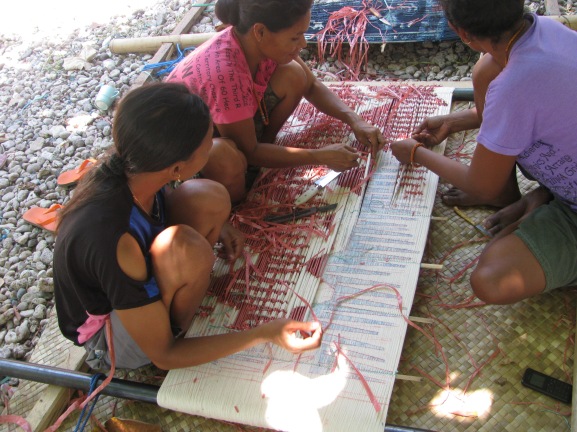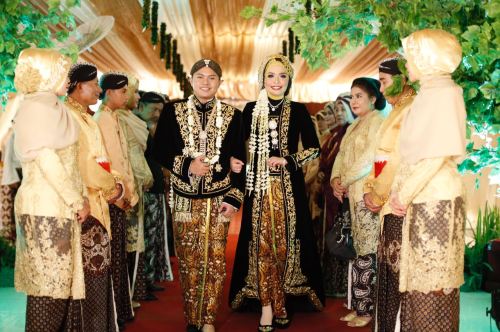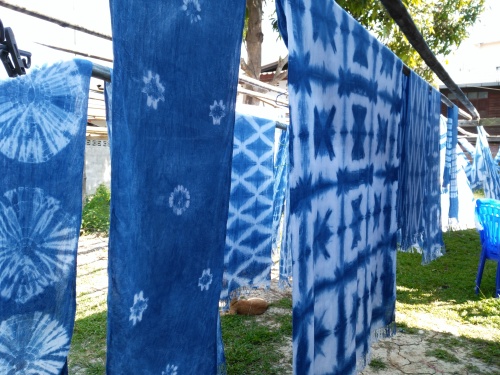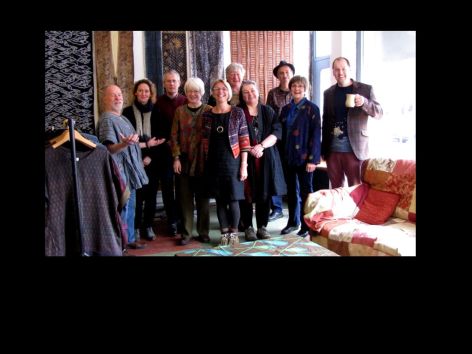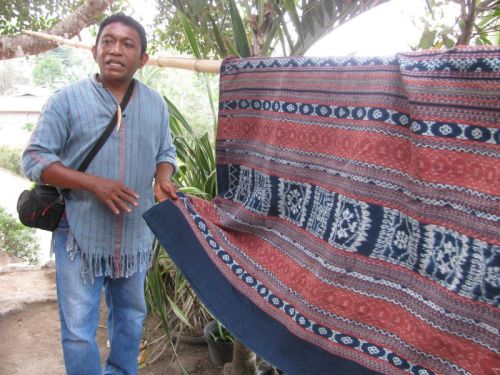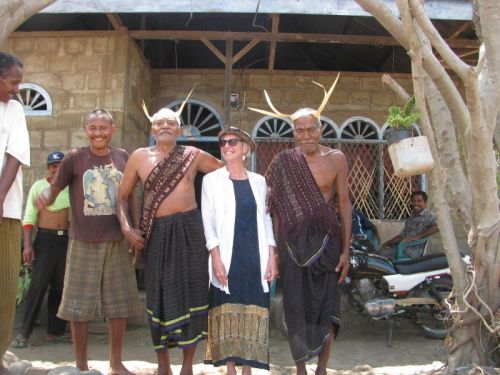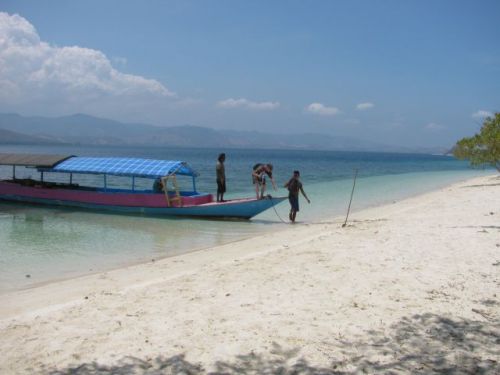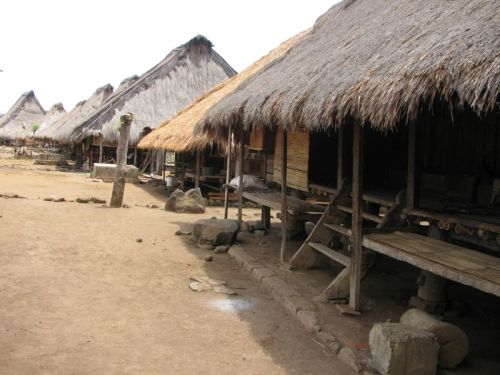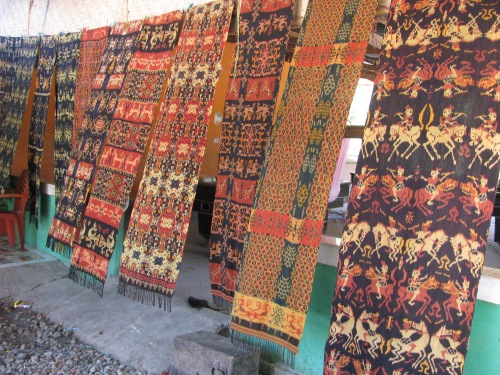
An array of single width ikat cloths
Sumba is one of a chain of islands spreading out east of Bali and it has been beckoning me for years. Why? Well, it’s textiles of course. Beautiful, colourful warp ikat blankets with big bold patterns. Finally we’ve stopped putting it off for lack of time or money and got our arses over here. Very few tourists seem to make it and those that do, come for other reasons. The suntanned youth come for the surf beaches, the more well-heeled (usually middle aged couples with a guide and driver) come for the traditional villages or the wildlife. Jim and I are a weird hybrid – middle aged with backpacks.
We land at Waingapu with its small, old fashioned airport just a couple of miles out of town and head in along dusty streets lined with little shops and past a crowd of people peering over a wall. It’s a monthly horse racing event. The Sumbanese love horses and in the early evening we see one of the horses draped in an ikat cloth being led home. It’s my first sighting of ikat. So, the horses wear it but the women don’t. In Sumba, it seems, ikat textiles are preserved for ceremonial use only and everyday wear is just like anywhere else in Indonesia: shorts, jeans, tee-shirts and maybe a printed batik sarong. A few old ladies wear dark hand-loomed sarongs but that’s it.
To find women making ikat you probably need to visit some tribal villages, right? So that’s our first mission. The villages’ swooping tall thatched roofs are sometimes up on a hill but, disconcertingly they can be right in the middle of town too.
You climb up the cobbled street, past the massive concrete or stone tombs as big as megalithic dolmen, try to avoid the ferociously barking dogs and sign the ubiquitous visitors’ book. Give a donation. Feel a bit voyeuristic and slightly awkward as you peer at people’s houses, try to walk round the pesky still-barking dogs, grubby little kids, big black pigs, and rubbish dumps. Until the 21st century, chucking your rubbish on the ground made not much difference; it either decomposed or you could burn it. Now most of the rubbish is plastic; plastic bottles and bags and packaging, and that doesn’t go away and can’t be burned (although many people try) It just stays and chokes up the gullies and the barefooted kids play in it.

A traditional village in East Sumba with its’ grave stones
I have no idea how it must feel to live in these homes, but to me they seem dark, hot, dirty, enclosed and the graves overpower everything. Basically, its poor and shit and I don’t blame young people for wanting out. So I’m not too impressed with traditional villages even though they are really impressive, if that makes any sense?
Still enough moaning, we’re here to find ikat. There are women weaving on back strap looms but the cloths they show us are either hugely expensive or not very attractive. But I have developed excellent skills in sniffing out textiles (searching the sparse clues in the guide book for a start!) and it’s not very long before we’ve found a little shop full of gorgeous ikat textiles. We start off chatting to the owner in Indonesian but when he finds out we’re British, he switches to near perfect English to tell us that he’s been to Art in Action in Oxfordshire twice to sell his ikat (along with a weaver to demonstrate). Before you know it, we’re onto shameless name dropping. Oh yes, he knows John Gillow, and Jenny Balfour Paul came here to research indigo and guess what! in a couple of days here’s off to Timor to meet the Richardsons. Can you believe it? Luckily we can hold our own in the name dropping department as we know all these textile superstars very well.
Freddy knows an awful lot about the warp ikat of East Sumba and I therefore grab the opportunity to ask as many questions as I can. I have ten days here and I need to know where to start looking. He tells us there’s no point going anywhere else but East Sumba (that’s not quite true, there’s some good ikat in West Sumba too) and there’re only a couple of places where natural dyes are still being used to dye the yarn. As an example, the mud dyed yarn which is being woven in his back room is now only made by one old lady. He is worried that fewer and fewer people have the skills to continue to make really high quality textiles.
So here are a few of the interesting things I began to understand about warp ikat…
It’s all about teamwork
It’s not really appropriate to ask who made a particular textile. In fact the weaver is just one of a team and hers is not even the most important of the skills. Probably each cloth has had input from 10 to 12 people. It starts with drawing the pattern, you need someone with a good sense of style and design, hen there are the people who tie the design – usually a team of them. Then there’s the natural dyeing. Good plants have to be grown and processed to make the dyestuff strong and light-fast. The dyeing is fairly complicated and it takes a long time. Then there’s removing the ties, setting up the loom, locking down the pattern (very important when you’re doing figurative work) and finally there’s the weaving. So, up to a dozen different people, sometimes specialists in their bit, often members of a family all helping, and several months, even a year, go into making a cloth.
Manspreading
A generation ago this was all women’s work because the cloths were used more or less exclusively for ceremonial exchanges. In a way they were an indicator of the family’s wealth because they showed how many hours the women of the family could be spared from the work of farming. These days, ikat has become more of a commercial proposition and a way of making money, so men have got involved in tying, dyeing and even weaving. Nowadays, Freddy reckons, probably more than half of an ikat is made by men.
What dyes are used?
The main colours used in Sumba are
- Blue – which comes from indigo leaves (indigofera tinctoria), used with powdered lime obtained from baked white coral. Indigo dye can be made from the fresh leaves or preserved as a paste which is reactivated with water strained through wood ash.
- A deep, rich red from the roots and root bark of morinda (morinda cirtifolia) known in Sumba as kombu with a very important addition of loba leaves (symplocus fasciculata) to add brightness to the colour. Morinda root is peeled and pounded and squeezed in water to make small balls. These are best used within a few days to retain their potency. Freddy is himself a morinda dye specialist and supplier. And that’s a cue to tell us about his latest venture, an upmarket little boutique hotel in the hills outside Waingapu, appropriately it’s called “Morinda”.
- Yellow comes from peeled and pounded turmeric rhizome (which looks like ginger) and kayu kuning heartwood (maclura cochinchinensis) All dyes benefit from a pre-mordant of either grated coconut or candlenut.
To get a really good depth of colour the yarns are dyed and re-dyed many times and thoroughly dried in between.
What’s it all for?
So if it’s not to wear, why do they put all this time, skill and effort into making fine ikat? In Sumba ikat is made to give, to exchange and to cement relationships between families. The cloths are essential at births, marriages and funerals and at communal ceremonies.
For example, at a marriage settlement, the groom’s family offer metal (particularly gold) and livestock and the bride’s family offer textiles.
At a funeral, friends, family and neighbours of the deceased bring textiles and other animals to slaughter (pigs and buffalo especially) and livestock (horses and cows). Everything is noted, and I mean actually noted down in a notebook. It is someone’s job to write down the quantity and the quality of every offering given and who gave what.
So not just any old ikat cloth will do, it will be looked at and the quality and fineness of the design and weave and the dyeing all noted. Freddy says that when his mother died, the family were given 300 ikat textiles! Often the body is wrapped in dozens of cloths and buried with them. A cloth given for a funeral may have a portion of the fringe cut away, so that it can’t be sold afterwards, and you can’t pass it on like an unwanted Christmas present either!
Of course this sets up huge responsibilities and ties of reciprocity which seem rather irksome to me. How can you ever escape from the circle of giving and then receiving and having the obligation to give again? But then maybe that is a big part of what makes a cohesive traditional culture what it is?
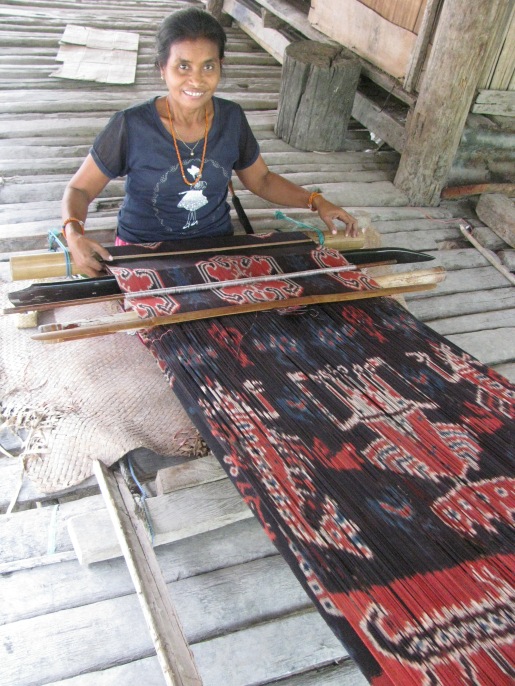
Weaving a typical ikat
I remember reading about this in “Indonesia Etc” by Elizabeth Pisani which begins with her visits to Sumba. The ties of ikat are both physically and metaphorically binding!
There are “kings” and there are “slaves”!
Sumba has a pretty rigid class system – the upper classes (or rajas), the middle class and the slaves or servant class. Some of the traditional villages are for families of so called Rajas or kings. We visited one of these villages called Rende where we sat on the porch of a huge dark wooden house and drank coffee with two kind and smiling red toothed ladies. We were gently harangued by a rather unattractive youth “Yes we are Rajas, we are all Rajas here” he says, with his scruffy shorts and scabby legs.
Meanings and symbols
Sumba ikat blankets are chock full of symbols, and humans and so many animals: komodos (monitor lizards), flat fish, shrimps, monkeys, frogs, horses, dogs, crocodiles, elephants and lions. Then there’s the patola design or “Bunga Raja” (the King’s flower) imitating the incredibly fine and expensive double ikat patola cloths which were first traded from India and had a profound influence on Indonesian textiles. The bamboo leaf signifies a new beginning and the crayfish which symbolises life after death as it shucks off its old shell and takes a new one. The designer can choose any of these and put them together as she wishes. The less repeats there are in a design, the more expensive the cloth will be, as the tying process will take longer.
After pumping Freddy for information, it’s only fair to buy a couple of his pieces, fabulous of course, but expensive, as is to be expected! Now I’m on the hunt for more.
The next day we’ve got a motorbike and we’ve found another village – but this time it’s a lovely spread out village with normal tin roofed houses and no barking dogs. There are massive piles of yarns with their tell-tale plastic ties hanging out to dry, the local shop has stacks of loba leaf parcels, women can be glimpsed weaving behind their homes and even the church has ikat design panels on the front
The first day we came to this “ikat hotspot” Dhigo, a sleepy young chap had to be roused from his bed to open up his shop. It was a Sunday and no-one else was around. On Monday when we come back, it’s a completely different story. Mom and Pop are here and they clearly rule the roost. There are 5 brand spanking new Toyotas in the garage and their grown up children (including younger son Dhigo) with their families live in houses nearby. In the shade of a beautiful rain tree, a team of 8 young men and women (are they slave class I wonder) are using bright plastic string to tie a design. They work quickly and efficiently wrapping, tying and snipping, chatting all the while. Different coloured string helps to distinguish which bits will stay on all through the dyeing process (where the design will stay the original white) and which will need to be removed after the first indigo dyeing so that the yarns can be dyed red.
Each frame of yarns will actually make 4 lembar (sheets). Full size blankets are made of two lembars sewn together lengthways. So each tying and dyeing operation is enough to make two large or 4 narrower cloths.
Something I hadn’t appreciated until I recently did a warp ikat course in Flores, is the importance of “locking” down the design. One end of the yarns holds the pattern key to the whole design – it make be a simple zigzag pattern but it is very important. After all the dyeing processes are done (which may take several months with the warp yarns just hanging around the place getting baked in the sun) the warps will be stretched out onto the warping frame. Now this “key pattern” will be adjusted until it comes together, and then suddenly and almost miraculously the whole pattern emerges. Before the warps are transferred to the back-strap loom for weaving the pattern is “locked in” at least 4 or 5 places along the length of the warp with bamboo sticks and more plastic baler twine.
Pop invites us in to the main house to show us his hugely impressive stacks of cloths with their hugely impressive traditional designs (lots of horses, buffalo, and male and female Rajas) We are offered the most teeth-clenchingly sweet tea I’ve ever had (and that’s saying something in Indonesia) Pure diabetes in a cup. Then the betel nut comes out, and we pass on that. Pop tells us Mom loves it. Makes her giddy he says! The postman turns up to deliver a parcel and gets invited to sit down and take some. Dhigo comes over, and decides that it really is time that we tried betel. Luckily Jim is game for a go, and I manage to avoid it by filming him. Hilarity ensues!
Lots of people in Sumba chew betel, and the bright red lips, red teeth and deep orange spit stains all over the ground testify to that. The chew is a mixture of dried areca nut and betel leaf taken together with a dash of white lime powder. It makes your mouth water with a bright red liquid which you spit out and it gives a high like drinking a strong cup of coffee or smoking a fag. Both of which Jim loves. Don’t think he was too keen on the betel though.
Older women particularly seem pretty addicted to it, but in Sumba men and women old and young enjoy it. If you want to make a village lady give you an absolutely delighted smile, present her with a small bag (about 10,000 rps – 60p’s worth will do it) of “sirih pinang”

Me and my new best friend (see what betel nut does for you!)
Finally it’s time to start really buying, and I end up striking the deal with Dhigo’s wife, Anna for a dozen or so cloths. They are all made in the village, all the dyes are natural plant dyes, and the designs are all beautiful. When we get them back to our room and spread them out, they look awesome. I imagine they will look even more amazing back in Shropshire!
East Sumba is dry and arid but its people and its textiles are a joy. Now we just have to sell these and we can come back again in another couple of years’ time.
 Isaan Province, north east Thailand. OK – it’s never going to be high on any tourists’ list of “must dos” but there is something very appealing about getting away from the crowds of “farangs” and Asian tour buses, and striking out into “The Real Thailand”. And especially when there is the promise of exciting textiles!
Isaan Province, north east Thailand. OK – it’s never going to be high on any tourists’ list of “must dos” but there is something very appealing about getting away from the crowds of “farangs” and Asian tour buses, and striking out into “The Real Thailand”. And especially when there is the promise of exciting textiles!











 Bangkok is a massive sprawling city, nicknamed “The Big Durian” a reference to New York’s “Big Apple”, only substituting the notoriously stinky tropical fruit. That’s a bit unfair these days. Memories of my first visit to Bangkok in 1982 are of a dark and dirty city with murky canals which gave off a particular damp, fusty smell and people eating at tiny street food stalls under very weak light bulbs. The food-stalls are still here, thank the Lord, but the canals have mostly been paved over, the city is bright with neon lights, and now extremely modern with hundreds of sky scraper office blocks, condominiums and hotels. Wide traffic-clogged highways sweep through the city. These massive obstructions make walking even short distances uncomfortable and impractical so its tempting to get on a tuktuk taxi only adding to the massive traffic jams and the humid polluted atmosphere. The “sky train” has helped a bit to get people around but there are not enough stations and they have a very steep steps to negotiate.
Bangkok is a massive sprawling city, nicknamed “The Big Durian” a reference to New York’s “Big Apple”, only substituting the notoriously stinky tropical fruit. That’s a bit unfair these days. Memories of my first visit to Bangkok in 1982 are of a dark and dirty city with murky canals which gave off a particular damp, fusty smell and people eating at tiny street food stalls under very weak light bulbs. The food-stalls are still here, thank the Lord, but the canals have mostly been paved over, the city is bright with neon lights, and now extremely modern with hundreds of sky scraper office blocks, condominiums and hotels. Wide traffic-clogged highways sweep through the city. These massive obstructions make walking even short distances uncomfortable and impractical so its tempting to get on a tuktuk taxi only adding to the massive traffic jams and the humid polluted atmosphere. The “sky train” has helped a bit to get people around but there are not enough stations and they have a very steep steps to negotiate.



